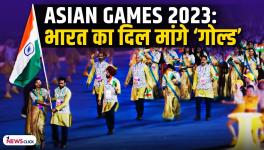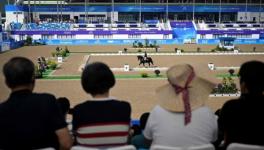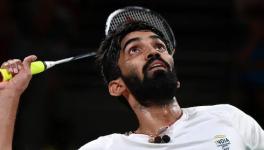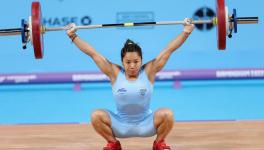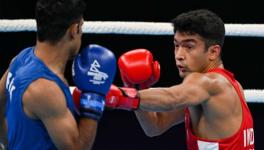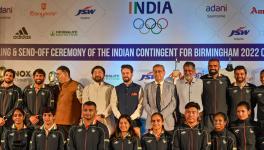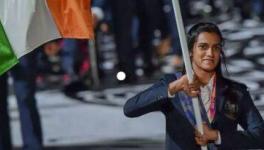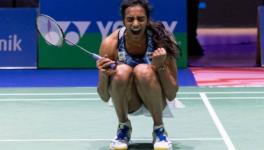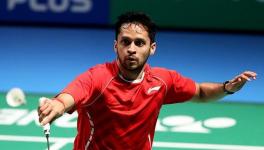PV Sindhu, Saina Nehwal and the Still Elusive Asian Games Medal
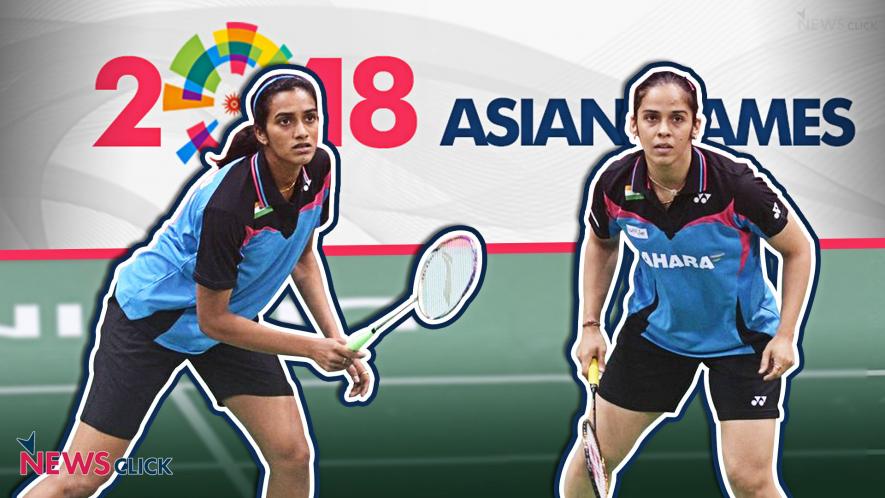
PV Sindhu and Saina Nehwal, going by ranking and recent performances, are among the favourites to win a medal at Asian Games 2018 but it will not be a cakewalk for the Indian badminton superstars.
It is not exactly objective to try and correlate results from a team badminton event with the prospects in the individual event. Without meaning to question an athlete’s desire or motivation, surely a winnable individual medal takes precedence over a situation where the results are not just your own. The argument is even more absurd when the battle has already been played and lost. But, looking at the way Saina Nehwal made life difficult for Nozomi Okuhara, and how PV Sindhu brushed past Akane Yamaguchi in the second game of the India vs Japan team tie at the Asian Games, one couldn’t help but feel encouraged at the prospect of the singles’ battle on the horizon.
Unlike some other major sports where the quality of opposition at the Asian level is considered suspect, badminton holds strong. Over the past two Olympics, five of the six medals in the women’s competition were won by Asian players. The men’s event mimics that statistic. Go a little further back, and we saw Asia sweep the medals (players from the continent won every single medal across every discipline in badminton at the 2008 Olympics in Beijing).
The point proven is that badminton at the Asian Games is not a pushover event, and as much as we try to not read into outcomes, badminton results at the Asian Games may be read into (with a pinch of salt, taking into account the distance between Jakarta Palenbang 2018 and the Tokyo Olympics). Of far more important value is the discussion whether India, now considered among the powerhouses in the world game, has made any strides to justify the position.
Also Read | Gold Sweat: Vinesh Phogat’s Gritty Journey to Historic Asian Games Triumph
If the team event is any indicator then we have taken a step back. In the 2010 Asian Games in Guangzhou, spearheaded by a young Saina Nehwal (a young Saina who had captured the media’s attention with a quarterfinal exit in Beijing, but was far from a mainstream star), India were knocked out in the first round. In 2014, contrary to predictions but keeping with expectations, India made the semifinals -- beating Indonesia 3-2 in an extraordinary high blood pressure inducing encounter -- and eventually won bronze in the women’s event.
The win in the quarters against Indonesia was powered by Saina Nehwal and PV Sindhu (then a young star with a World Championship bronze in 2013), and despite a stumble in the doubles, Sindhu and Ashwini Ponnappa wrapped up a remarkable victory in the doubles match to seal India’s bronze.
Walking into this edition though, there was hope of some alchemy, that have now been ground to dust by the No. 1 ranked women’s team in the competition -- Japan, who beat India 3-1 in the quarterfinals to advance into the medal rounds.
The Missing Medal
Despite the growing profile of the sport in the country, the stark truth is that India has not won a medal in the singles event at the Asian Games since 1982 when Syed Modi sealed a bronze in front of a partisan New Delhi crowd. For those among our readers interested in absurd facts, in that same period of time, India has had 10 Prime Ministers, three different parties taking charge of government, have hosted the Commonwealth Games, and captured two medals at the OLYMPICS in the sport!
Also Read | Teen Saurabh Chaudhary Wins Gold in 10 metre Air Pistol Event at Asian Games
And still, Asia remains a distant dream. In fact, PV Sindhu’s father Ramana Sindhu has won a medal at the Asian Games (bronze, volleyball 1986) in the time since India’s last singles medal on the badminton court.
And keeping with the trend, these Games couldn’t have come at a worse time. We are still reeling from Sindhu’s epic capitulation against Carolina Marin in the World Championships final last month. We are also reeling from the simple statistic that no Indian player has won a BWF world tour title yet -- Sindhu has been to and lost three finals now; Saina has the one single appearance and loss. If we include the men, Sameer Verma is the only Indian to have won a title this season -- a Swiss Open triumph in February.
And still, during this four-year churn over continental event, not only is there hope for a medal, in some sections of the media, the dream is of a finals sweep.
Former India doubles player, KT Rupesh Kumar, laughs at this suggestion without actually dismissing it.
Also Read | Indian Kabaddi Team Shocked by Korea as Draw Opens up at Asian Games
“We are a young nation when it comes to badminton,” he says. “People keep saying that we aren’t winning, but the truth is that you have to learn to lose, to win. As a country, as players from this country, sometimes the fear of losing takes the game away from us. You are afraid, and don’t trust yourself. The players may not have won titles yet this year, but at the big tournaments, they have all reached the medal rounds. When the big moments have come, the big game players have stepped up.”
For no one does this statement hold truer than PV Sindhu. She may have lost three finals (four including the Commonwealth Games, where she was beaten by Saina), but the fact that she made four finals (and a semifinal at the All England Club) is a testament to her growth as one of the big tournament players, in a sport that thrives on big tournaments.
“There is a lot of discussion about the fact that she lost in the finals again, to Marin. But consider the fact that she has won four consecutive medals at the World Championships, an unprecedented feat. It isn’t easy to be at that stage consistently. And she is always there,” Rupesh says.
Evolving Sindhu
By all accounts, Sindhu is still a player growing into a world beater. We may already consider her a great, but the truth is year in year out, a newer Sindhu emerges, flaws ironed out, evolving, coach Pullela Gopichand constantly chipping away to create a masterpiece.
Also Read | Bajrang Punia, From Indian Wrestling Protege to Protagonist
Last year, Sindhu’s nemesis were the Japanese duo of Nozomi Okuhara and Akane Yamaguchi. Sindhu faced off against the duo four times last year and ended their head-to-head at 2-2. Okuhara famously won their World Championships duel. Two weeks on, Sindhu beat her and took the Korea Open title. This year, Sindhu bested her twice in their three encounters. Yamaguchi has been similarly served. More importantly, the victories have come on the bigger stages -- at the All England and the World Championships last month. One has followed the other.
Some of this can be attributed to a change in course, a stylistic maneuvering of her game.
“She and Gopi have obviously sat down and tried to figure out the chinks in her armour, against this pair (Japanese),” Rupesh says. “In the World Champs she was 19-13 down against Yamaguchi but mounted a great comeback. She is not allowing them too much time for retrieval. They are great defensive players, and Sindhu instead of attacking relentlessly, is now relying on drop shots and selective attacking to beat them.”
The results, tiringly eked out, are there to see.
Also Read | Ranked Favourites But Tricky Gold Quest for Indian Hockey Teams at Asian Games
Saina’s record against Okuhara is much better than Sindhu’s (6-2, albeit over the past year it is a more believable, 1-1) but against Yamaguchi she has a 1-6 head-to-head (she has lost the last six in a row).
In her defence though, these statistics are moot. At this stage of her career, her game isn’t defined by clear strengths and clear weaknesses. There are no highlights that can accurately point out her inadequacies. There are no corrections and strengths that can definitively stick. Without meaning to, sometimes she loses the plot, and without seeming to, she sometimes seizes the narrative.
Like in the second rubber of the team event against Okuhara. Down 10-16 in the second game, with the first game lost, she mounted a comeback least expected by anyone watching. She saved four match points in that game and finally took it 25-23. While she was eventually out lasted in the third game and beaten by the Japanese, everyone watching has learnt a hard lesson -- a beaten Saina is your worst nightmare.
Also Read | Legacy of Independent India’s First Hockey Olympic Gold in 1948
All of this makes for compelling statistical reading, but the Japanese are not the only dangers. Others, with more compelling resumes, lurk. Sindhu will be compelled to face Okuhara in as early as the quarterfinals, but may also have to face off against Chinese Taipei’s Tai Tzu-Ying even before the final.
Their head-to-head makes for abysmal reading. She is 0-5 against the World No. 1. Her last victory came almost two years ago. Saina’s record is worse; she is 5-11 and has lost the last nine in a row. Thailand’s Ratchanok Inthanon, is another to consider among the medals.
By no means will the Asian Games be a pushover, and they never have been. For all those dreaming of a medals sweep, it is perhaps advised to hold your horses. A favourable draw may lead India to the medal rounds, but this continent is the gold standard of badminton and gold here is worth every drop of sweat it begets.
Get the latest reports & analysis with people's perspective on Protests, movements & deep analytical videos, discussions of the current affairs in your Telegram app. Subscribe to NewsClick's Telegram channel & get Real-Time updates on stories, as they get published on our website.









